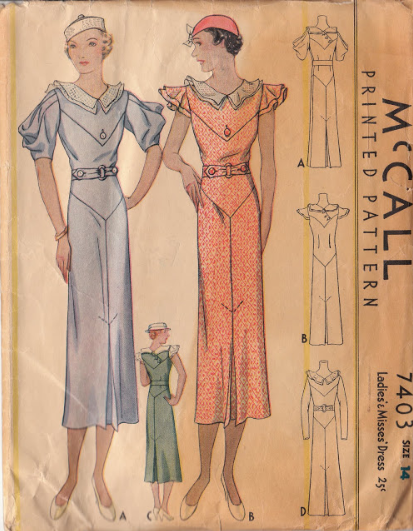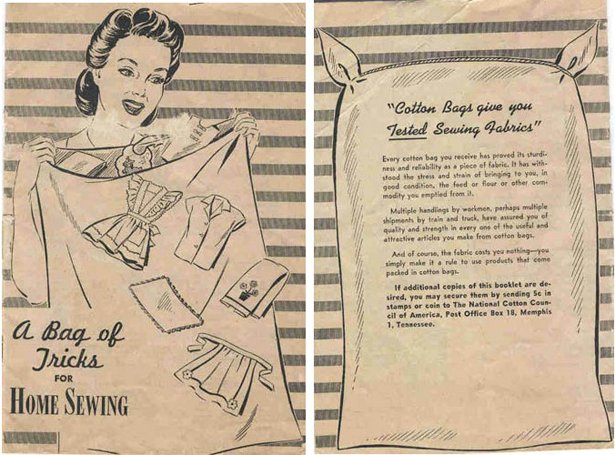The stock market crash, known as Black Tuesday, occurred in November of 1929. The over-indulgent 1920s suddenly halted to a new stark reality of economic vulnerability. The 1930s saw two broad spectrums in fashion, one of glamour and the other born of poverty in what is known as The Great Depression.
Fashion of the 1930s saw the birth of the tea dress. Dresses became more contoured, waistlines rose, and hemlines dropped to mid to lower calf or 'tea length'. These were often made of chiffon and adorned with ruffles (a.k.a. jabots), flutter sleeves, and the art deco beading of the 1920s was now seen in interesting deco seam lines.
Day dresses saw interesting, higher necklines, bows, single pleated skirts, and puff sleeves often made of linen.
The tea dress and day dress are general changes seen in the 1930s. As mentioned previously, this time period in the U.S. experienced economic disparity. The market crash was just the beginning as those in the mid-west were suffering from a record long drought. Farmers had over planted, depleting the once rich soils. With no modern forms of irrigation, nutrient depleted lands, and long periods of drought, farmers literally saw their crops turn to mere dust in what is referred to as The Dust Bowl. Feed supply companies found it more difficult to sell their goods, and came up with the idea of packaging feed in floral printed cotton sacks. Sales rose as families re-purposed these bags into clothing and other household necessities. Thus came the entry of the 'feedsack dress'.
These dresses were cotton, so they were easy to care for, and usually had a small floral (a.k.a. calico) print.
Even farther out west, a glimmer of hope would arise in Hollywood, California. American cinema was widely seen in a movie called "Birth of a Nation" in 1915. From that point up until the late 1920s, films were produced with music overlays and graphics of scripted conversation known as the Silent Film Era. While wildly popular, cinema shifted with conversational soundtracks in the late 1920s to give birth to 'the talkies.' This new innovation would give rise to the Movie Star. For the first time, audiences could see and hear those on the screen, giving the actors a new dimension of identity.
At a time when most of the country was experiencing deep poverty and despair, Hollywood churned out films filled with stories of wealth and glamour. Hollywood knew the country needed a respite from the reality of their daily struggles, something starkly different to raise hopes and dreams. It was a risky gamble, but what arose were icons of inspiration. The 1930s lifted the careers of Ginger Rogers and Fred Astaire, Mae West, Sonja Henie, Clark Gable, and many many more. The most iconic, though, for this time period was Gene Harlow. Her platinum blonde hair, thin arched eyebrows and pouty doll-like makeup, and brash film personality left audiences equally mesmerized and entertained. She is known as THE sex symbol of the 1930s. Much of this also has to do with a style she made famous. Forever, her legacy will be infused with the 1930s satin bias cut dress.

This was an extravagant dress for its time. Most people don't know what 'bias cut' means and why the fabric drapes so differently in this style. I'll explain this very briefly below.
When you buy fabric, it is folded in half in a long continuous strip measured in yards. An average dress is cut vertically on the folded fabric. A bias cut is cut horizontally with the fabric fold open.
A traditional cut dress with fabric folded. Pattern pieces are placed horizontally onto the fabric. "Selvages" are the opposite end of the fold, where the open ends of the fabric meet.
A bias cut dress. The fabric is open and the pattern pieces are placed diagonal.
The fabric reacts differently when bias cut. It drapes and stretches like a traditional cut dress wouldn't. This distinction is important because while so many families used re-purposed feed sacks to clothe their families, the new bias cut dress wasted as much, if not more, fabric than what it used. The practicality of wasting so much fabric was just not viable for most women of the 1930s. Still, this is the image most people equate with 1930s fashion.
As The New Deal was signed, and new infrastructure jobs put the poor back to work, prosperity started to rise once again by the late 1930s. The country was on the mend but activities across the Atlantic would soon arise and take women out of the home to work in factories, causing yet another, more practical change in fashion. I'll go into more detail in the next segment covering the 1940s.













































